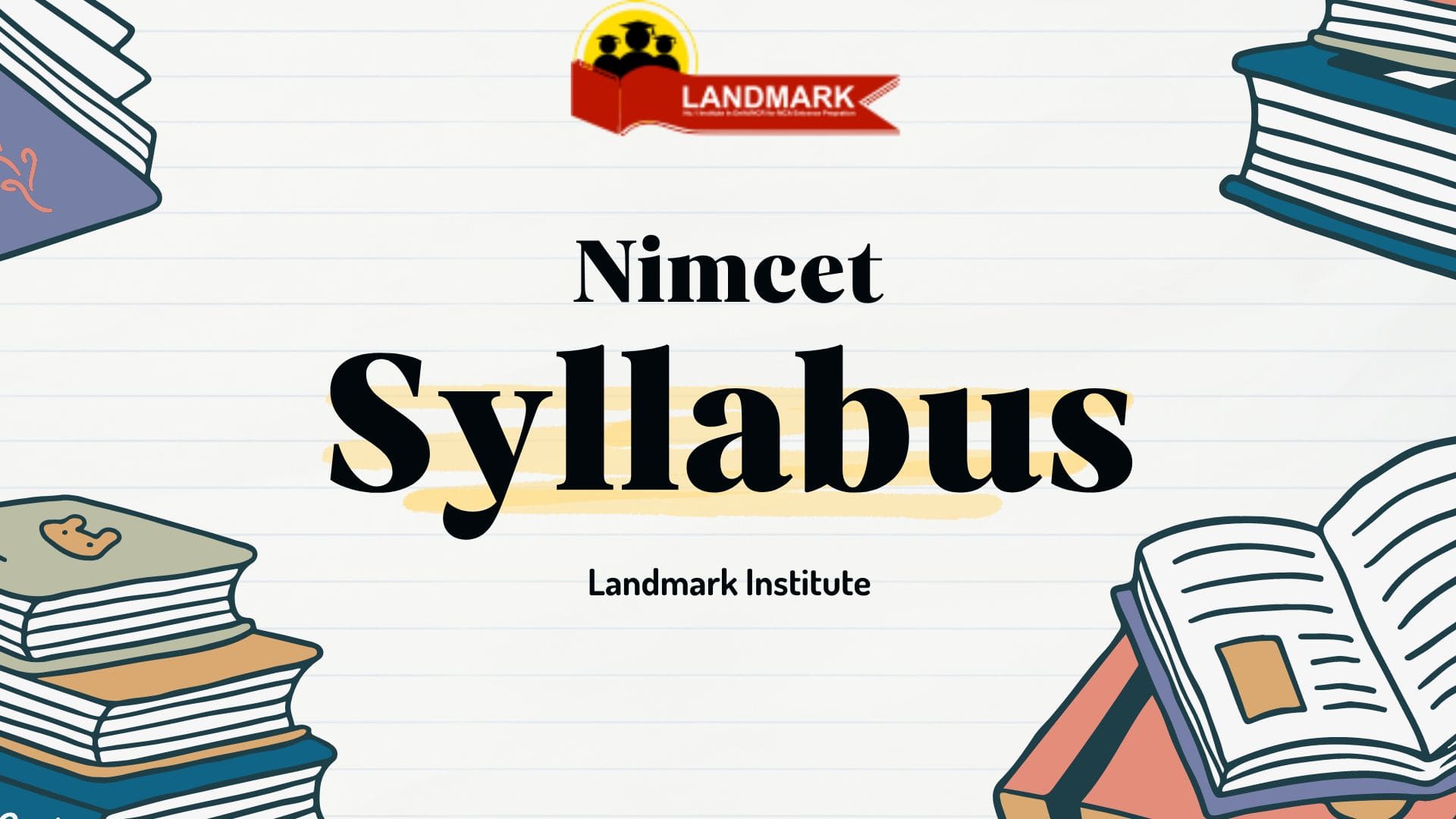Nimcet Syllabus | MCA Entrance Exam Syllabus- 2025-26

Nimcet Syllabus | MCA Entrance Exam Syllabus- 2025-26
Check the complete nimcet or MCA Entrance Exam Syllabus. Landmark Institute will help you to cover it in very smart way easily by our experts’ team.
There is no unified syllabus for M.C.A. entrance exam Landmark follows the syllabus given below which covers the syllabi of all the Universities / Institutes.
Part 1
Mathematics
Matrices & Determinants
Matrix operation, Adjoint and inverse of a matrix, Rank of a Matrix; Cayley Hamilton Theorem, Eigen Values, Eigen Vectors, Latent Vectors, Linear System of equations, properties of determinants, Cramer’s rule.
Differential Calculus
Continuity and Limits, Total and Partial Differentiation,Properties of continuous Functions, Rolle’s Theorem, L.M.V. Theorem, Cauchy’s generalized mean value theorem,Taylor’s and Maclaurin’s Series, Maxima and Minima,Indeterminate form, L. Hospital’s rule, Curvature,Asymptotes, Tangent & normal, Tracing of curves,Successive Differentiation, Functions of two or more variables, Applications of derivatives such as tangent and normal, rate as a measure, increasing and decreasing functions etc.
Integral Calculus
Definite and Indefinite Integral, Evaluvation of Length, Area and Volume of Curves, Multiple Integration, Change of order, Change of Variables, Application to find Area, Volume.
Differential Equations
Differential equations of first order and their solutions, Linear differential equations with constant coefficients, Homogenous Linear Differential Equations, Orthogonal Trajectories, Introduction to Differential Equations of Second order, Complimentary Function, Particular Integrals.
Real Analysis
Real Number system, concept of neighbourhood and limit points, order completeness property, Archemedian Property, Sequence, Sequences of real Numbers, Bounded sequences, Covergent sequences, Cauchy Sequences, Monotonic sequences, Infinite series of positive terms and their different tests of convergence, Alternating series, Leibnitz’s test, Absolute convergence. Conditional Convergence.
Algebra
Sets, Relations, functions, Simultaneous linear equations,Quardratic Equations, Indices, Logarithms, A.P., G.P., H.P.,Inequalities, Surds, Binomial Theorem, Complex numbers, Demoivere’s Theorem, Roots of unity, Roots of a complex number,geometry of complex numbers.
Theory of Equations
Polynomials and their characteristics, Roots of an equation, Relation between Roots and coefficients, Transformation of equations.
Trigonometry
Trigonometric Functions, Trigonometric Identities,Trigonometric Equations, Properties of triangles, Solution of triangles, Properties of Triangle, Height and distance; Inverse trigonometric function, Applications of trigonometry in coordinate geometry.
Co-ordinate Geometry (2D)
Slope of a line, Different forms of a straight line, Family of lines, Pair of straight lines, Translation of Axes, Circles, Family of circles, coaxial system of circles, Parabola, Ellipse, Hyperbola, Equation of Tangent, Pair of tangents from a point, Chord of contact, Equation of chord in terms of middle point, Pole and polar of a conic, Diameter of a conic, Conjugate Diameter, Classification of curves of second degree.
Co-ordinate Geometry (3D)
Straight Line, Plane, Sphere, Right Circular Cylinder, Cone.
Abstract Algebra
Groups, Permutation groups, Subgroups, Lagrange’s theorem, Order of an element of a group, Normal subgroups, Quotient Groups, Homomorphism, Isomorphism, Automorphism, Endomorphism, Rings, Field, Vector spaces, Linear Dependence and Linear Independence of vectors, Basis, Dimension,Linear Transformation, Quardratic Forms, Diagonalisation of matrices.
Numerical Techniques
Interpolation, Extrapolation, Simpson’s 1/3rd rule, Trapezoidal rule, Numerical differentiation, Numerical Integration, Use of Iterative Methods (Bisection Method, Newton- Raphson method, Gauss Method, Gauss-Jacobi Method etc.) to solve system of equations, Convergence of various iterative methods, Rate of Convergence etc.
Statistics
Classifications of Data and Frequency distribution, Calculation of measures of Central tendency and measures of dispersion, Skewness & Kurtosis, Correlation & Regression, Index numbers, Time Series Analysis
Probability
Permutation & combination, Probability, Random Variables & distribution functions, Mathematical Expectations & generating functions, Binomial, Poisson, Geometric, Exponential & Normal Distributions, Sampling & large sample tests, Tests of significance based on t, Chi-square and F distributions.
Part 2
General Aptitude and Logical Ability
General Aptitude and Logical Ability
It includes questions on Logical deduction, Vocabulary, Simple arithmetic,interpretation of Data, Problem and Puzzle solving, Flow charts and Algorithms.
This test is mainly designed to test the grasping and logical ability of the candidate.
Part – 3
Elementary English Awareness
Elementary English Awareness
This test is aimed to check the basic level understanding of candidate in English language. It includes reading comprehension,simple Synonyms,Antonyms, Idioms, Phrases etc.
Part – 4
Computer Awareness
Computer Basics
Organization of a computer, Central Processing Unit (CPU), Structure of instructions in CPU, input / output devices,computer Memory, memory organization, back-up devices.
Computer Mathematics
Mathematical Logic
Venn Diagrams in logic, Logical operators, Negations, Logical Equivalence and Tautology, Flow Chart and Algorithms.
Data Representation
Representation of characters, integers, and fractions, binary and Hexadecimal representations.
Binary Arithmetic
Addition, subtraction, division, multiplication, single arithmetic and two complement arithmetic, floating point representation of numbers, normalized floating point representation, Boolean algebra, Truth tables, Venn diagrams.
Computer Architecture
Block Structure of computers, communication between processor and I / O devices, Interrupts.
